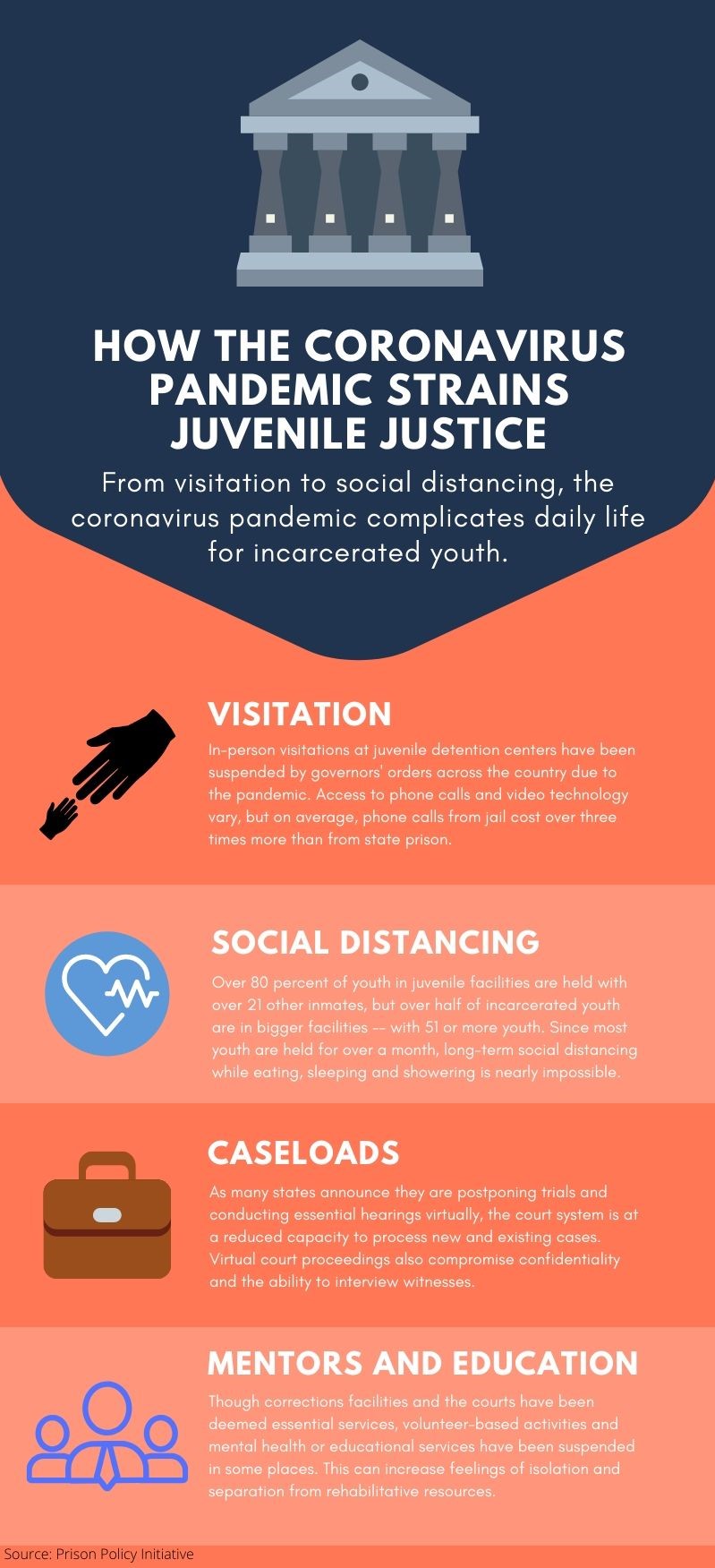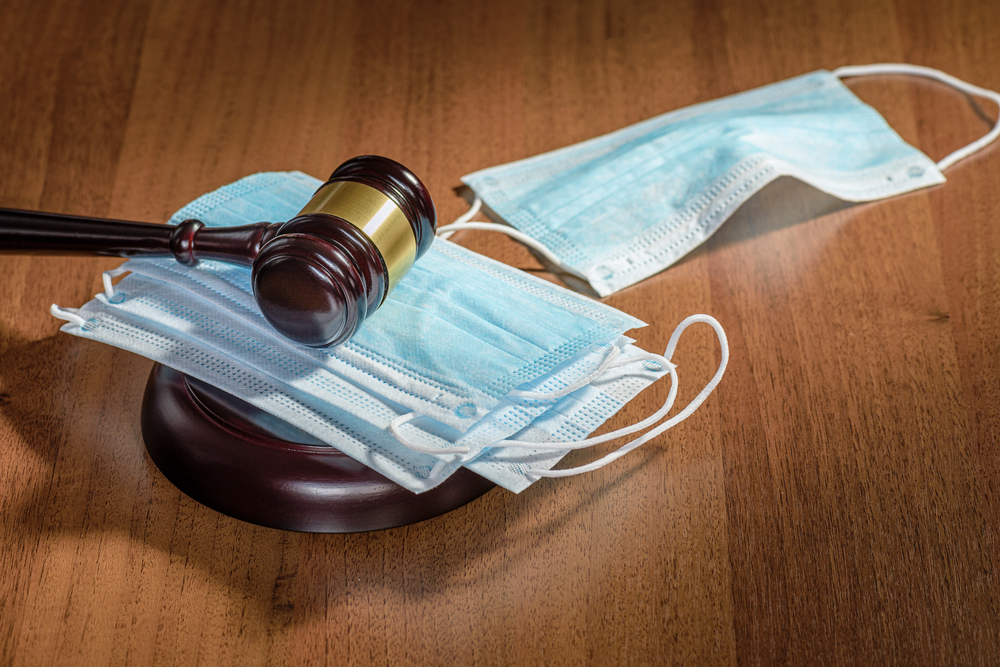As the U.S. enters its fourth month of battling the coronavirus pandemic, states continue to evaluate ways to redirect new juvenile cases and monitor inmates.
On a given day, nearly 60,000 youth are incarcerated, the ACLU estimates. And though youth crime overall has been on a steady decrease, this network that imprisons youth in the U.S. faces a new problem: the coronavirus pandemic.
“This is so different,” said Shoshana Paige, a senior public defender in Whatcom County, Wash. — a middle-income county on the Canadian border. “This is one big bugaboo that no one has any control over.”
Recently, some states have been pressured to release young, nonviolent offenders to their homes or other safe places due to fear of the virus spreading in correctional facilities. As youth face isolation from their families, suspended trials and inability to social distance, that pressure grows.
District attorneys, law enforcement and corrections workers are working to keep COVID-19 out of correctional centers while also trying to deter new admissions to minimize harm to those working or serving time inside.
“On one hand, I want them to be taking all the precautions that they can to keep the kids who are there safe,” Paige said. “But short of just letting them all out, I'm not sure what else they can do.”
Fearing a prison outbreak
Families of those incarcerated are also demanding answers about protective measures against the virus.
Lee Beers is serving nine years in Florida, currently at the Graceville Work Camp in Jackson County, which is on the northwest border with Alabama. He also has a condition that could put him at higher risk for COVID-19.
Now 28, Lee was an accomplished teenager in Hernando County, west of Orlando. In high school he was a volunteer firefighter and football player who was being scouted to play after graduation.
But one day he got injured on the field. Knowing that surgery might limit his future ability to play, he did what any aspiring athlete might do: tough it out and go home with a prescription painkiller to ease recovery.
He was sent home with oxycodone.
“Slowly but surely my little white picket fence, all the pieces started getting pulled out,” his mother Mary Beers said. “We realized that he was acting funny. He wasn't the same person. That’s how it all began.”
What started as a few simple drug charges for Lee turned into stealing his mother’s debit card.
He told the judge in his case, “I’m not going to prison. It’s a setup for failure,” then spent the next year there. After that, he started using harder drugs and stole a vehicle. At that point, Mary Beers said, the judge was willing to offer a reduced sentence in combination with a few years in drug and mental health treatment.
But before the court could finalize that sentence, he racked up another charge.
“And now he's sitting in there on completely nonviolent charges, in close quarters with guards that are coming in,” she said.
Mary Beers said her son will also do two years of mental health and drug treatment when he returns home on house arrest. But she said he is not receiving any treatment while incarcerated.
As of Tuesday, there are 285 COVID-19 youth diagnoses in juvenile facilities, with at least 28 states reporting cases affecting youth, staff or both, according to data by the Sentencing Project.
Florida’s Department of Juvenile Justice reported seven positive cases among juvenile inmates and 25 cases among correctional staff as of Tuesday.
Paige said that while it’s one thing to try to reduce new intakes, it’s another to deal with youth inside who suddenly can’t visit with family, meet with mentors or social distance from other inmates and guards.
In many states, visitation was the first thing to go as the virus spread.
Making visitation work virtually
In Washington state, juveniles can’t make calls unless the family has paid for time, Paige said. This is standard in many jails and prisons across the U.S.
Mary Beers said she pays $20 to $30 a week to phone her son through JPay, a national company based in Florida that wires money to inmates for calls, among other services.
Because of the pandemic, Washington state and Florida’s departments of corrections have been able to offer reduced costs for phone calls and video. In-person visits were suspended throughout Florida.
The Washington state Department of Corrections suspended visits at all 12 state facilities but that didn’t apply to county jails or detention centers. In Whatcom County, in-person visits at the county jail are limited to weekends with a single visitor at a time and only one-hour sessions.
The mother of one of Paige’s clients tried to visit her son that month. She was turned away from the facility and soon after, she died.
Paige said her client believed his mother wasn’t able to visit because of coronavirus restrictions, though Paige said she doesn’t know if there were other reasons.
“It’s the worst possible circumstance,” she said.
She stressed the importance of family contact, especially during the pandemic.
“One of the things that I find so horrific about our local policy in general is that you can have visits from your parents, but what about your siblings?” Paige said. “Those are important family relationships, too.”
Like many other jurisdictions, Paige said Whatcom also lacks some of the technology to communicate via video or teleconference.

Mary Beers said she has experienced issues with video visitation since in-person visits were suspended in Florida April 30 through this Sunday. She said the video was down three out of four times she tried to call. She often doesn’t know if the video will work until she tries to connect.
When she has been able to contact her son, Beers said he’s been scared.
“One of the things he had written to me said, ‘Mom, I'm scared I'm never going to see you again,’” Beers said. “So I called him and I tried to calm him … And he says, ‘What happens when all the guards get sick, and there's nobody here to keep control?’”
She said the danger stems from having so many inmates housed together, even with precautions to social distance, medical quarantine and wear masks, which the Florida Department of Corrections has listed as ways it's responding to the pandemic.
But David Garlock, a criminal justice advocate and former inmate in Alabama, said there’s too much potential for a public health disaster inside prisons without releasing nonviolent inmates or inmates nearing the end of their sentences, for example.
“Would I be able to say I did my job as a politician allowing 3,000 men and women to die in prison than if one person gets out, commits another crime and 3,000 people stay healthy?” he said.
Prosecuting new offenses during a pandemic
The coronavirus pandemic also affects new offenders.
In Paige’s jurisdiction, many of the juveniles are in detention because of parole violations, she said.
When asked how local judges are reducing new cases, Paige said they’ve been sensitive to the potential harm of locking youth up in order to slow intake and minimize contact between people as much as possible.
For example, two of her clients were arrested while on probation. But instead of issuing a new charge, the prosecutor chose to file it as a violation.
This difference is key. Processing a violation as a new charge complicates the situation, as it adds an additional crime — and potentially additional sentences — on top of a probation violation, according to legal definitions.
In places like Whatcom, where juvenile arrests frequently come from parole violations, this softer approach aims to deter new trials and corrections admissions.
New York has been targeted as another state where mass incarceration of parole violations impedes “decarceration” efforts, according to the Prison Policy Initiative.
“A lot of these individuals could have a five-year sentence, but you’re actually giving them a death sentence because of the way the virus is spreading,” Garlock said.
And for one in five youth in juvenile facilities, the most serious charge they face is a status offense or technical violation, which is in itself a low-level, nonviolent offense, according to Prison Policy Initiative.
To adapt, some courts have factored public health into sentencing decisions. Judges have weighed whether detaining a juvenile with runaway history, which Paige said her county deals with, is safer than releasing them back to their homes where they risk the health of family.
Another of Paige’s clients was recently arrested while on probation. The youth lived with great-grandparents and had been breaking curfew. During the trial, she said the probation officer tried to make the youth’s late-night escapades a violation on the grounds that it also violated quarantine and risked the life of his elderly family.
Paige said that was struck down as an illegitimate probation violation, though she said the youth still spent time in juvenile detention before being sent back home.
“The kids who are [facing charges] so far have been the ones who are either facing a real serious, violent charge, or they’re kids who have the chronic runaway history,” she said. “I think the judge feels like, ‘Well, this kid is at risk, but who’s at risk if they’re running away?’”
With schools closed and children forced to stay at home, Paige also said stressful home environments or separation from healthy friendships or mentors outside the home can exacerbate runaway tendencies.
“It’s a real challenge,” she said. “It’s an isolating place in general because you don’t have much interaction except with the detention officers and maybe some of the other kids.”
So the new legal question some judges and attorneys are asking themselves because of the pandemic is whether youth are safer in detention or at home.
And like everything else coronavirus affects, there’s no precedent.
Garlock said the issue is two-fold: protecting juveniles during the pandemic means reducing mass incarceration and lengthy sentences, but also rigorous health screening for those already inside — including workers.
“It’s a breeding ground for this [virus],” he said.
Uncertainty looms for courts
As corrections and legal scramble to figure out how to protect youth already in the system, questions still remain about what to do about any new offenses committed during quarantine.
Paige said while attorneys and courts are still trying to process cases that began before quarantine, it’s difficult when the inmate is in prison and the legal team is scattered between home and court.
She said she has no way to maintain confidentiality with clients who are inmates.
“If you didn't already have the technology, well, we're one of many places that's struggling to have whatever we need just to allow basic court stuff to still function,” Paige said.
The Washington State Supreme Court suspended all jury trials until after July 6. Paige said that for youth waiting on trials, she can’t even give them or their families an estimated court date because of the pandemic’s uncertainty.
And for Paige and her team, they fear a massive backlog once stay-at-home orders lift and courts must address the months of work that was put on hold.
The Trump administration, which has offered mixed advice about the coronavirus epidemic in the U.S., has not issued a federal directive on whether, or how, federal inmates will be released.
On April 3, U.S. Attorney General William Barr encouraged the Bureau of Prisons to release high-risk inmates to at-home confinement under the Coronavirus Aid, Relief and Economic Security (CARES) Act.
This story has been updated.
